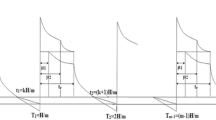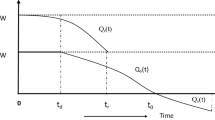Abstract
This paper investigated two warehouse inventory model for a single deteriorating items under the assumption of shortages and partial backlogging under payments delay and the effect of inflation and time value for money is also incorporated. Again, two warehouse capacity (owned and rented) have been considered over the finite horizon planning under which back-ordering is assumed. When the order quantity becomes higher than the storage capacity in own warehouse then the system involves two warehouse model. In this model, excess inventory are stored in rented warehouses which are assumed to charge higher unit holding costs than owned warehouses. Moreover, in rented warehouse item deteriorates with higher rates than in owned warehouse. At first own warehouse are filled out by its storage capacity and the rests are kept in rented warehouse. So, at first, the items in RW decreases due to demand and deterioration until it reaches to the level zero while on the other hand a portion on the inventory on OW is depleted due to deterioration only. Then, the inventory on OW decreases due to demand and deterioration until it reaches to the level zero. Finally, shortages start and backlogging rate is negative exponential of function waiting time. Here, the demand is used as exponential function of time and backlogging rate varies negative exponential function of waiting time. The total cost function is carried out under the effect of JIT setup cost. Two numerical examples are illustrated for the developed model and sensitivity analysis has been carried out to identify behaviour of model parameters.





Similar content being viewed by others
References
Hartely, V.R.: Operations Research—A Managerial Emphasis, pp. 315–317. Santa Monica, CA (1976)
Goswami, A., Chaudhuri, K.S.: An economic order quantity model for items with two levels of storage for a linear trend in demand. J. Oper. Res. Soc. 43, 157–167 (1992)
Sarma, K.V.S.: A deterministic order-level inventory model for deteriorating items with two storage facilities. Eur. J. Oper. Res. 29, 70–73 (1987)
Pakkala, T.P.M., Achary, K.K.: A deterministic inventory model for deteriorating items with two warehouses and finite replenishment rate. Eur. J. Oper. Res. 57, 71–76 (1992)
Zhou, Y.W., Yang, S.L.: A two-warehouse inventory model for items with stock-level-dependent demand rate. Int. J. Prod. Econ. 95, 215–228 (2005)
Lee, C.C.: Two-warehouse inventory model with deterioration under FIFO dispatching policy. Eur. J. Oper. Res. 174, 861–873 (2006)
Yang, H.L.: Two-warehouse partial backlogging inventory models for deteriorating items under inflation. Int. J. Prod. Econ. 103, 362–370 (2006)
Jaggi, C.K., Cardenas-Barron, L.E., Tiwari, S., Shafi, A.: Two-warehouse inventory model for deteriorating items with imperfect quality under the conditions of permissible delay in payments. Sci. Iran. Trans. E 24(1), 390–412 (2017)
Tiwari, S., Cardenas-Barron, L.E., Khanna, A., Jaggi, C.K.: Impact of trade credit and inflation on retailer’s ordering policies for non-instantaneous deteriorating items in a two-warehouse environment. Int. J. Prod. Econ. 176, 154–169 (2016)
Sett, B.K., Sarkar, B., Goswami, A.: A two-warehouse inventory model with increasing demand and time varying deterioration. Sci. Iran. Trans. E Ind. Eng. 19, 306–310 (2012)
Shah, N.H.: A lot-size model for exponentially decaying inventory when delay in payments is permissible. Cahiers du CERO 35, 115–123 (1993)
Aggarwal, S.P., Jaggi, C.K.: Ordering policies of deteriorating items under permissible delay in payments. J. Oper. Res. Soc. 46, 658–662 (1995)
Jamal, A.M.M., Sarker, B.R., Wang, S.: An ordering policy for deteriorating items with allowable shortages and permissible delay in payment. J. Oper. Res. Soc. 48, 826–833 (1997)
Sarkar, B.: An EOQ model with delay-in-payments and time-varying deterioration rate. Math. Comput. Model. 55, 367–377 (2012)
Chung, K.J., Liao, J.J.: Lot-sizing decisions under trade credit depending on the ordering quantity. Comput. Oper. Res. 31, 909–928 (2004)
Chung, K.J., Liao, J.J.: The optimal ordering policy in a DCF analysis for deteriorating items under trade credit depending on the ordering quantity. Int. J. Prod. Econ. 100, 116–130 (2006)
Shinn, S.W., Hwang, H.: Optimal pricing and ordering policies for retailers under order-size-dependent delay in payment. Comput. Oper. Res. 30, 35–50 (2003)
Huang, K.N., Liao, J.J.: A simple method to locate the optimal solution for exponentially deteriorating items under trade credit financing. Comput. Math. Appl. 56, 965–977 (2008)
Liao, J.J.: On an EPQ model for deteriorating items under permissible delay in payments. Appl. Math. Model. 31, 393–403 (2007)
Liao, J.J.: A note on an EOQ model for deteriorating items under supplier credit linked to ordering quantity. Appl. Math. Model. 31, 1690–1699 (2007)
Chen, S.-C., Cardenas-Barron, L.E., Teng, J.T.: Retailer’s economic order quantity when the supplier offers conditionally permissible delay in payments link to order quantity. Int. J. Prod. Econ. 155, 284–291 (2014)
Ghare, P.M., Schrader, G.P.: A model for an exponentially decaying inventory. J. Ind. Eng. 14, 238–243 (1963)
Covert, R.P., Philip, G.P.: An EOQ model for items with Weibull distribution deterioration. Am. Inst. Ind. Eng. Trans. 5, 323–326 (1973)
Cheng, M., Zhang, B., Wang, G.: Optimal policy for deteriorating items with trapezoidal type demand and partial backlogging. Appl. Math. Model. 35, 3552–3560 (2011)
Chung, K.J., Lin, S.D.: The inventory model for trade credit in economic ordering policies of deteriorating items in a supply chain system. Appl. Math. Model. 35, 3111–3115 (2011)
Cardenas-Barron, L.E.: The economic production quantity (EPQ) with shortage derived algebraically. Int. J. Prod. Econ. 70, 289–292 (2011)
Widyadana, G.A., Cardenas-Barron, L.E., Wee, H.M.: Economic order quantity model for deteriorating items and planned back-order level. Math. Comput. Model 54, 1569–1575 (2011)
Chung, C.J., Widyadana, G.A., Wee, H.M.: Economic production quantity model for deteriorating inventory with random machine unavailability and shortage. Int. J. Prod. Res. 49, 883–902 (2011)
Sarkar, M., Sarkar, B.: An economic manufacturing quantity model with probabilistic deterioration in a production system. Econ. Model. 31, 245–252 (2013)
Sarkar, B., Sarkar, S.: Variable deterioration and demand—an inventory model. Econ. Model. 31, 548–556 (2013)
Sarkar, B., Saren, S., Wee, H.M.: An inventory model with variable demand, component cost and selling price for deteriorating items. Econ. Model. 30, 306–310 (2013)
Sarkar, B.: A production-inventory model with probabilistic deterioration in two-echelon supply chain management. Appl. Math. Model. 37, 3138–3151 (2013)
Sarkar, B., Saren, S., Cardenas-Barron, L.E.: An inventory model with trade-credit policy and variable deterioration for fixed lifetime products. Ann. Oper. Res. 229(1), 677–702 (2016)
Sarkar, B., Mandal, B., Sarkar, S.: Preservation of deteriorating seasonal products with stock-dependent consumption rate and shortages. J. Ind. Manag. Optim. 13(1), 187–206 (2017). https://doi.org/10.3934/jimo.2016011
Wu, J., Al-khateeb, F.B., Teng, J.T., Cardenas-Barron, L.E.: Inventory models for deteriorating items with maximum lifetime under downstream partial trade credits to credit-risk customers by discounted cash-flow analysis. Int. J. Prod. Econ. 171, 105 (part 1)–115 (2016)
Sarkar, B., Saren, S., Cardenas-Barron, L.E.: An inventory model with trade-credit policy and variable deterioration for fixed lifetime products. Ann. Oper. Res. 229(1), 677–702 (2015)
Shah, N.H., Cardenas-Barron, L.E.: Retailer’s decision for ordering and credit policies for deteriorating items when a supplier offers order-linked credit period or cash discount. Appl. Math. Comput. 259, 569–578 (2015)
Ray, J., Chaudhuri, K.S.: An EOQ model with stock-dependent demand, shortage, inflation and time-discounting. Int. J. Prod. Econ. 53, 171–180 (1997)
Chen, J.M.: An inventory model for deteriorating items with time-proportional demand and shortages under inflation and time discounting. Int. J. Prod. Econ. 55, 21–30 (1998)
Bose, S., Goswami, A., Chaudhuri, K.S.: An EOQ model for deteriorating items with linear time-dependent demand rate and shortages under inflation and time discounting. J. Oper. Res. Soc. 46, 771–782 (1995)
Sarkar, B., Sana, S.S., Chaudhuri, K.S.: A finite replenishment model with increasing demand under inflation. Int. J. Math. Oper. Res. 2(3), 347–385 (2010)
Roy, T., Chaudhuri, K.S.: A finite time-horizon deterministic EOQ model with stock level-dependent demand, effect of inflation and time value of money with shortage in all cycles. Yugosl. J. Oper. Res. 17(2), 195–207 (2007)
Sana, S.S.: A production-inventory model in an imperfect production process. Eur. J. Oper. Res. 200, 451–464 (2010)
Roy, T., Chaudhuri, K.S.: A finite time horizon EOQ model with ramp-type demand rate under inflation and time-discounting. Int. J. Oper. Res. 11(1), 100–118 (2011). Kindly check and confirm the inserted page range is correctly identified for the reference [44]
Ouyang, L.-Y., Yang, C.-T., Chan, Y.L., Cardenas-Barron, L.E.: A comprehensive extension of the optimal replenishment decisions under two levels of trade credit policy depending on the order quantity. Appl. Math. Comput. 224, 268–277 (2013)
Wu, J., Ouyang, L.Y., Cardenas-Barron, L.E., Goyal, S.K.: Optimal credit period and lot size for deteriorating items with expiration dates under two-level trade credit financing. Eur. J. Oper. Res. 237(3), 898–908 (2014)
Chung, K.J., Cardenas-Barron, L.E., Ting, P.S.: An inventory model with non-instantaneous receipt and exponentially deteriorating items for an integrated three layer supply chain system under two levels of trade credit. Int. J. Prod. Econ. 155, 310–317 (2014)
Yang, H.H.: Two-warehouse inventory models for deteriorating items with shortages under inflation. Eur. J. Oper. Res. 157, 344–356 (2004)
Hou, K.L.: An inventory model for deteriorating items with stock-dependent consumption rate and shortages under inflation and time discounting. Eur. J. Oper. Res. 168, 463–474 (2006)
Cardenas-Barron, L.E., Chung, K.J., Trevio-Garza, G.: Celebrating a century of the economic order quantity model in honor of Ford Whitman Harris. Int. J. Prod. Econ. 155, 1–7 (2014). (2006)
Liao, J.J., Huang, K.N.: Deterministic inventory model for deteriorating items with trade credit financing and capacity constraints. Comput. Ind. Eng. 59, 611–618 (2010)
Sarkar, B., Saren, S.: Product inspection policy for an imperfect production system with inspection errors and warranty cost. Eur. J. Oper. Res. 248, 263–271 (2016)
Sarkar, B.: Supply chain coordination with variable back order, inspections, and discount policy for fixed lifetime products. Math. Prob. Eng. 2016, 14 (2016). https://doi.org/10.1155/2016/6318737
Sarkar, B., Sarkar, S., Yun, W.Y.: Retailer’s optimal strategy for fixed lifetime products. Int. J. Mach. Learn. Cybern. 7, 121–133 (2016)
Tripathi, R.P., Chaudhary, S.K.: Inflationary induced EOQ model for Weibull distribution deterioration and trade credits. Int. J. Appl. Comput. Math. 3, 3341–3353 (2017). https://doi.org/10.1007/s40819-016-0298-9
Das, P., De, S.K., Sana, S.S.: An EOQ model for time dependent backlogging over idle time: a step order fuzzy approach. Int. J. Appl. Comput. Math. 1(2), 171–185 (2015)
Sarkar, B., Sana, S.S., Chaudhuri, K.S.: An Economic production quantity model with stochastic demand in an imperfect production system. Int. J. Serv. Oper. Manag. 9(3), 259–283 (2011)
Acknowledgements
The authors wish to thank the anonymous referees for their helpful comments and suggestions which greatly improved the content of the article.
Author information
Authors and Affiliations
Corresponding author
Appendix A
Appendix A
From Eq. (3) we obtain order quantity \(Q=I(0)=\frac{a}{\alpha + b}(e^{(\alpha + b)t_{1}}-1)\) and if the order quantity \(Q\le W\) then it is unnecessary to rent any warehouse. Thus \(\frac{a}{\alpha + b}(e^{(\alpha + b)t_{1}}-1)\le W\) implies \(t_{1} \le \frac{1}{\alpha + b}log(1+\frac{(\alpha + b)W }{a})\). For simplicity, let \(t_{a}=\frac{1}{\alpha + b}log(1+\frac{(\alpha + b)W }{a})\). The inequality \(Q\le W\) holds if and only if \(t_{a}\ge t_{1}\). Therefore, the inequality \(Q>W\) holds if and only if \(t_{a}< t_{1}\) which implies that there are W units of items stored in OW and the remainder are despatched in RW.
Rights and permissions
About this article
Cite this article
Chakrabarty, R., Roy, T. & Chaudhuri, K.S. A Two-Warehouse Inventory Model for Deteriorating Items with Capacity Constraints and Back-Ordering Under Financial Considerations. Int. J. Appl. Comput. Math 4, 58 (2018). https://doi.org/10.1007/s40819-018-0490-1
Published:
DOI: https://doi.org/10.1007/s40819-018-0490-1




